5 Best mini ITX cases
Are you a PC enthusiast looking to build a powerful rig without compromising on space? Look no further than mini ITX cases, These compact wonders pack a punch, offering a perfect balance of performance and size.
In this article, we’ll explore the top mini ITX cases on the market, providing you with a comprehensive guide to help you choose the perfect case for your needs. Whether you’re a gaming aficionado or a creative professional, our selection of mini ITX cases will ensure your build is both stylish and efficient.
Best mini ITX cases
| Serial No. | Product Name | Check Price |
| 1 | NZXT H210i | Check Price |
| 2 | Cooler Master NR200 | Check Price |
| 3 | Fractal Design Node 304 | Check Price |
| 4 | SilverStone Technology SG13 | Check Price |
| 5 | Thermaltake Core V1 | Check Price |
1. NZXT H210i
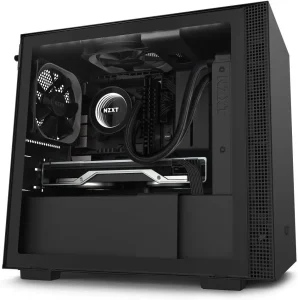
| Specification | Details |
| Tempered glass side panel | ✓ (with single screw installation) |
| Upgraded Smart Device V2 | ✓ |
| Max GPU Clearance | 265-325mm |
| Radiator Support | Front: 240mm or Rear: 120mm |
From the moment I laid my eyes on the NZXT H210i, I was captivated by its modern and minimalist design. The tempered glass side panel provides a stunning view of my meticulously crafted build, and the single screw installation makes accessing the components a breeze.
The addition of a USB 3.1 Gen 2-compatible USB-C connector on the front panel is a game-changer, allowing me to effortlessly connect the latest peripherals and high-speed external storage to my PC.
What truly sets the NZXT H210i apart is its upgraded Smart Device V2. With a faster microprocessor and NZXT CAM-powered control, I have complete command over two RGB lighting channels and three fan channels. Whether I want to choose from presets or create custom controls, the intuitive NZXT CAM application makes it a delight to monitor and fine-tune my build.
Pros:
- Sleek and modern design
- Easy installation with single screw tempered glass panel
- USB 3.1 Gen 2-compatible USB-C connector for seamless connectivity
- Upgraded Smart Device V2 for comprehensive control over RGB lighting and fans
Cons:
- Limited radiator support compared to larger cases
2. Cooler Master NR200
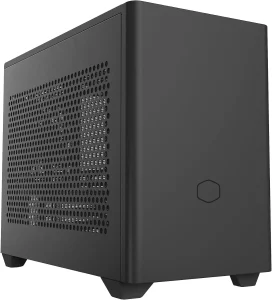
| Specification | Details |
| Vented Panel | Five ventilated steel panels |
| Cooling Potential | Holds up to 7 fans |
| CPU Cooler Compatibility | Up to 155mm tall |
| Radiator Compatibility | Up to 280mm long |
| Full-size GPU Compatibility | Triple-slot GPUs supported |
| Maximum GPU Length | 330mm |
| Maximum GPU Width | 156mm |
| 360 Degree Accessibility | Dismantlable panels for easy access |
| High-quality Materials | Thick, powder-coated SGCC steel |
| Custom Cooling Support | Multiple liquid cooling pump and radiator locations |
| Easy, Tool-free Access | Secure removal of external panels without tools |
The Cooler Master NR200 is a mini ITX case that packs a punch. With its five ventilated steel panels, airflow is unrestricted, ensuring optimal cooling for your components. I was delighted to find that this case can accommodate up to 7 fans, allowing me to create a cooling setup that keeps temperatures at bay.
One of the standout features of the NR200 is its compatibility with full-size GPUs. With support for triple slot GPUs up to 330mm in length and 156mm in width, this case grants me the freedom to choose powerful graphics cards for my compact build. The option for vertical mounting adds a touch of versatility to showcase my GPU in all its glory.
The 360-degree accessibility of the NR200 is a game-changer. Every panel and frame part can be dismantled, providing easy access to work on components. This level of convenience makes building and upgrading a breeze, allowing me to tinker with my setup without any restrictions.
The high-quality materials used in the construction of the NR200 ensure longevity. The thick, powder-coated SGCC steel not only withstands the test of time but also resists marring from transport or handling.
Pros:
- Unrestricted airflow with five ventilated steel panels
- Versatile cooling options with support for up to 7 fans and various liquid cooling configurations
- Full-size GPU compatibility for powerful graphics performance
- Easy access and disassembly with 360-degree accessibility
Cons:
- Limited CPU cooler height compatibility compared to larger cases
3. Fractal Design Node 304
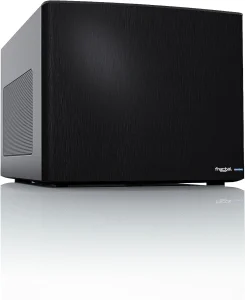
| Specification | Details |
| Hybrid Functionality | Three fully removable drive caddies for HDDs or SSDs |
| Cooling Performance | Two 92mm intake fans and one 140mm exhaust fan |
| Compact Design | Small footprint with ample interior space |
| Graphics Card Compatibility | Up to 12.2″ length supported |
| Drive Mounts | Accommodates up to 4 HDDs or SSDs |
| Cooling Options | Support for single-fan liquid cooling systems and tower-style CPU heat sinks (up to 165mm) |
The Fractal Design Node 304 may be small in size, but it packs a punch when it comes to options. With its hybrid functionality, I was able to customize my setup effortlessly. The three fully removable drive caddies supported both HDDs and SSDs, giving me the flexibility to build a cool-running file server or a stylish home theater PC with ease.
The cooling performance of the Node 304 was impressive right out of the box. Equipped with two 92mm intake fans and one 140mm exhaust fan from the Silent Series R2, this case provided high-performance cooling without any compromise. My components remained cool even during intense gaming sessions.
Despite its compact design, the Node 304 offered ample room for me to work inside the case. The small footprint did not restrict my ability to build and customize to my heart’s content. Whether I wanted to create a powerful gaming system or a sleek media center, Node 304 provided the necessary space for my creativity to flourish.
Pros:
- Hybrid functionality with removable drive caddies for versatile storage options
- Excellent cooling performance with included Silent Series R2 fans
- Compact design with ample interior space for easy customization
- Compatibility with long graphics cards and multiple HDDs or SSDs
Cons:
- Limited support for liquid cooling compared to larger cases
4. SilverStone Technology SG13
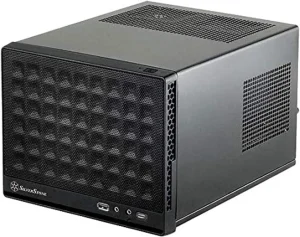
| Specification | Details |
| USB Type-C Front Port | Included (SST-SG13B-C only) |
| Expansion Card Compatibility | Supports standard-length cards (10.6 inches) |
| Motherboard & PSU Compatibility | Mini-DTX / Mini-ITX & ATX PSU compatible |
| Liquid Cooler Support | Supports 120mm or 140mm single fan All-in-One Liquid Cooler |
| Drive Compatibility | Supports 2.5″ and 3.5″ hard drives |
| Elevated Standoff | Provides space for motherboard back side components |
The SilverStone Technology SG13 is a game-changer in the world of mini ITX cases. With its sleek design and impressive features, it offers a level of compatibility and versatility that is hard to match. The inclusion of a USB Type-C front port (SST-SG13B-C only) is a welcome addition, ensuring that you stay up to date with the latest connectivity options.
I was pleasantly surprised by the expansion card compatibility of this case. With support for standard-length cards up to 10.6 inches, I had the freedom to choose from a wide range of graphics cards without compromising on performance. This allowed me to build a powerful gaming rig or a multimedia powerhouse with ease.
Compatibility is key when it comes to mini ITX cases, and the SG13 excels in this aspect. Whether you have a Mini-DTX or Mini-ITX motherboard, this case has got you covered. Furthermore, it is also compatible with ATX power supplies, ensuring that you have enough power for your components.
One standout feature of the SG13 is its liquid cooler support. With the ability to accommodate a 120mm or 140mm single fan All-in-One Liquid Cooler, I was able to achieve excellent cooling performance without sacrificing valuable space. My components stayed cool even during demanding tasks, allowing for smooth and reliable performance.
The drive compatibility of the SG13 is also worth mentioning. With support for both 2.5″ and 3.5″ hard drives, I had ample storage options for all my files and games. The elevated standoff for motherboard backside components provided additional space, making cable management a breeze.
Pros:
- USB Type-C front port (SST-SG13B-C only) for modern connectivity
- Compatibility with standard-length expansion cards
- Support for Mini-DTX / Mini-ITX motherboards and ATX power supplies
- Excellent liquid cooler support for efficient cooling
- Versatile drive compatibility with 2.5″ and 3.5″ hard drives
Cons:
- Limited space for cable management compared to larger cases
5. Thermaltake Core V1
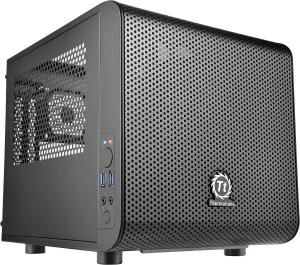
| Specification | Details |
| Motherboard Compatibility | Mini ITX |
| Front Ports | 2x USB 3.0, 1x Headphone, 1x Mic |
| Internal Bay | 2x 3.5 inches, 2x 2.5 inches |
| Fan Configuration | 1 x 200mm fan, 2 x 80mm turbo fans (optional) |
| Interchangeable Side Panels | Symmetrical panels for personalization |
| Adjustable I/O Panel Location | Customizable placement for convenience |
| Air/Liquid Cooling Options | Extreme configurations for superior cooling |
| Dual Modular Drive Rack Design | Versatile storage installation options |
| Chambers Concept | Advanced ventilation for optimal performance |
| Compact Size Expansion | Compatible with high-end system components |
The Thermaltake Core V1 is a mini ITX case that packs a punch. With its compact size and exceptional features, it stands out as one of the best options for those seeking a mini ITX case that doesn’t compromise on performance.
One aspect that impressed me about the Core V1 is its versatility. With support for Mini ITX motherboards, I was able to build a powerful system without sacrificing space. The case offers ample room for storage with its two 3.5-inch and two 2.5-inch internal bays, allowing me to easily install all my data storage devices.
When it comes to cooling, the Core V1 takes it to the extreme. The case comes with a 200mm fan and the option to add two 80mm turbo fans for optimal airflow. The interchangeable side panels not only add a touch of personalization but also contribute to the advanced ventilation system, keeping my components cool even during demanding tasks.
I was delighted to discover the adjustable I/O panel location, which allowed me to customize the placement of the front ports for easy access. This thoughtful design feature added convenience to my computing experience.
The Core V1’s dual modular drive rack design offers flexibility in storage installation, making it easy to configure my system to fit my needs. Additionally, the chamber concept further enhances the cooling and airflow within the case, ensuring that my components stay at the optimal temperature.
Despite its compact size, the Core V1 provides incredible expansion options. I was able to install a dual expansion slot VGA with a length of up to 260mm and a width of up to 40.5mm. The case also accommodated a tower CPU cooler with a height of up to 140 millimeters and a high-wattage PSU with a length of up to 180mm.
Pros:
- Versatile storage options
- Excellent cooling capabilities
- Customizable I/O panel placement
- Modular drive rack design
- Advanced ventilation system
- Outstanding expansion options
Cons:
- Limited space for cable management
- Optional turbo fans not included
Your Ultimate Buying Guide: 6 Factors to Consider When Choosing the Best Mini ITX Case
Are you on the hunt for the perfect mini ITX case to house your powerful system? Look no further! As an expert in the field, I’m here to provide you with a comprehensive buying guide that will help you make an informed decision. So, let’s dive in and explore the six key factors you should consider when choosing the best mini ITX case for your needs.
1. Size and Form Factor: Mini ITX cases come in various sizes, so it’s crucial to consider the dimensions and form factors that will fit your setup. Measure the available space and ensure the case fits comfortably without compromising airflow or cable management.
2. Cooling Capability: Efficient cooling is vital to keep your components running optimally. Look for a mini ITX case that offers ample ventilation, fan mounting options, and compatibility with liquid cooling solutions if you require enhanced cooling performance.
3. Storage Options: Consider the number and types of storage devices you plan to install. Opt for a mini ITX case that provides sufficient drive bays, both for traditional 3.5-inch hard drives and SSDs. Modular and tool-less designs can simplify the installation process.
4. Expansion Slots and GPU Compatibility: If you intend to use a dedicated graphics card, ensure that the mini ITX case has enough expansion slots to accommodate it. Check the maximum GPU length and width supported by the case to ensure compatibility with your chosen graphics card.
5. Connectivity and Front Panel Ports: Think about the connectivity options you require. Look for a mini ITX case with front panel ports that match your needs, such as USB 3.0 or USB-C ports, audio jacks, and additional ports like HDMI or Thunderbolt if necessary.
6. Build Quality and Aesthetics: Consider the overall build quality and design of the mini ITX case. Look for sturdy materials, thoughtful cable management, and easy access to components. Aesthetics also play a role, so choose a case that aligns with your style and complements your setup.
FAQs
1. Can I fit a full-sized graphics card in a mini ITX case?
Yes, many mini ITX cases offer sufficient space for full-sized graphics cards. However, it’s crucial to check the maximum GPU length and width supported by the specific case you are considering.
2. Do all mini ITX cases support liquid cooling solutions?
Not all mini ITX cases are designed with liquid cooling compatibility in mind. It’s important to check the specifications of the case you are interested in to see if it supports the installation of liquid cooling radiators and components.
3. How many storage devices can I install in a mini ITX case?
The number of storage devices a mini ITX case can accommodate varies. Some cases offer multiple drive bays for traditional 3.5-inch hard drives and SSDs, while others may have limitations.
4. Are front panel ports standardized in mini ITX cases?
No, front panel ports can vary across different mini ITX cases. The availability and types of ports like USB, audio jacks, HDMI, or Thunderbolt will depend on the specific case model you choose.
5. Are all mini ITX cases built with the same level of quality?
Mini ITX cases can vary in terms of build quality. While most reputable brands strive to provide sturdy and durable cases, it’s essential to read reviews and consider the materials used in the construction.
Conclusion
choosing the best mini ITX case for your needs requires careful consideration of various factors. By evaluating the size and form factor, cooling capability, storage options, expansion slots, connectivity, build quality, and aesthetics, you can find a case that perfectly suits your requirements.
Remember to measure your available space, check compatibility with your components, and prioritize efficient cooling and cable management. With the right mini ITX case, you can build a compact yet powerful system that fits seamlessly into your setup.